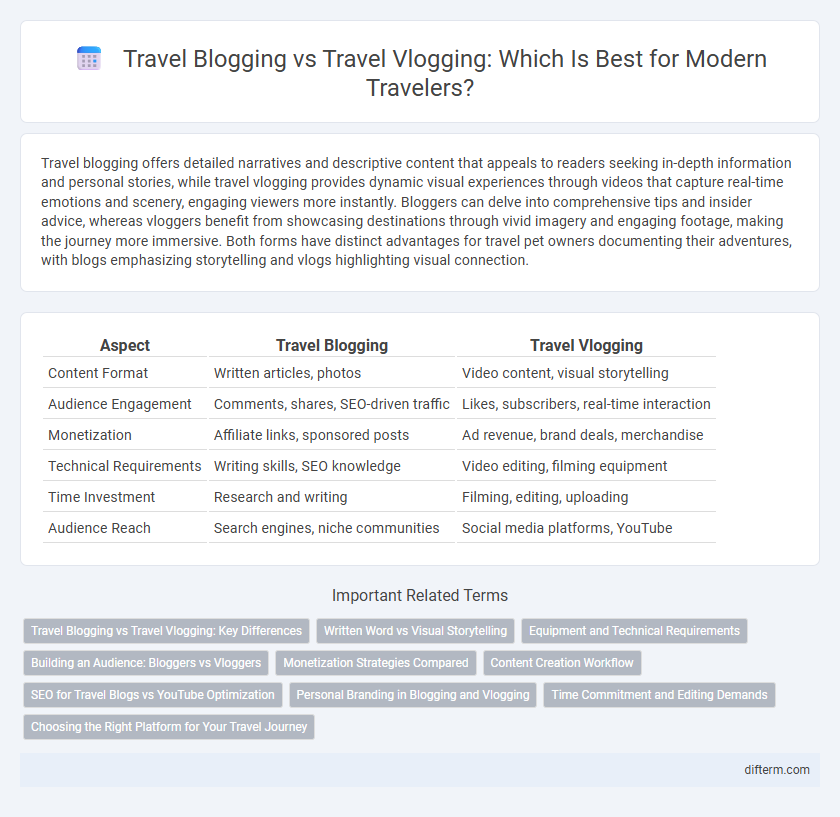Travel blogging offers detailed narratives and descriptive content that appeals to readers seeking in-depth information and personal stories, while travel vlogging provides dynamic visual experiences through videos that capture real-time emotions and scenery, engaging viewers more instantly. Bloggers can delve into comprehensive tips and insider advice, whereas vloggers benefit from showcasing destinations through vivid imagery and engaging footage, making the journey more immersive. Both forms have distinct advantages for travel pet owners documenting their adventures, with blogs emphasizing storytelling and vlogs highlighting visual connection.
Table of Comparison
| Aspect | Travel Blogging | Travel Vlogging |
|---|---|---|
| Content Format | Written articles, photos | Video content, visual storytelling |
| Audience Engagement | Comments, shares, SEO-driven traffic | Likes, subscribers, real-time interaction |
| Monetization | Affiliate links, sponsored posts | Ad revenue, brand deals, merchandise |
| Technical Requirements | Writing skills, SEO knowledge | Video editing, filming equipment |
| Time Investment | Research and writing | Filming, editing, uploading |
| Audience Reach | Search engines, niche communities | Social media platforms, YouTube |
Travel Blogging vs Travel Vlogging: Key Differences
Travel blogging primarily focuses on written content, offering detailed narratives and comprehensive guides enriched with SEO-friendly keywords to enhance online visibility. Travel vlogging relies on engaging video content, capturing real-time experiences and visual storytelling that appeals to audiences through platforms like YouTube and Instagram. Both mediums require unique skills: travel blogging demands strong writing and SEO knowledge, while travel vlogging emphasizes video editing and on-camera presence for maximum audience engagement.
Written Word vs Visual Storytelling
Travel blogging leverages the power of the written word to create immersive narratives, detailed guides, and evocative descriptions that engage readers' imaginations and provide in-depth information. Travel vlogging emphasizes visual storytelling through dynamic video content, capturing real-time experiences, emotions, and scenic vistas that resonate instantly with audiences. Both mediums offer unique opportunities to convey travel experiences, with blogging excelling in detailed, SEO-rich content, and vlogging thriving in engaging, shareable visual narratives.
Equipment and Technical Requirements
Travel blogging primarily requires a reliable laptop, quality camera for photography, and SEO tools to optimize written content for search engines, while travel vlogging demands more advanced equipment such as a high-resolution video camera, stabilizers, microphones, lighting gear, and powerful editing software to produce engaging visual content. Bloggers benefit from lightweight gear and portable chargers to maintain mobility, whereas vloggers must invest in versatile audio-visual tools including gimbals, drones, and external microphones to capture professional-grade footage on the go. Understanding these technical requirements helps creators tailor their equipment investments according to their preferred medium, ensuring optimal content quality and audience engagement.
Building an Audience: Bloggers vs Vloggers
Travel bloggers build an audience through SEO-optimized written content, leveraging keyword-rich articles to attract readers searching for detailed travel guides and tips. Travel vloggers engage viewers with visually captivating videos on platforms like YouTube and TikTok, utilizing storytelling and real-time experiences to foster emotional connections. While bloggers benefit from long-term content discoverability, vloggers achieve rapid audience growth driven by shareable, visually immersive content.
Monetization Strategies Compared
Travel blogging monetizes primarily through affiliate marketing, sponsored content, and display ads, leveraging written SEO-rich content to attract organic traffic. Travel vlogging generates income via YouTube ad revenue, brand partnerships, and merchandise sales, benefiting from visual engagement and higher viewer retention. Both strategies require niche targeting, consistent content creation, and audience interaction to maximize revenue streams effectively.
Content Creation Workflow
Travel blogging relies heavily on detailed written content, requiring research, drafting, editing, and SEO optimization to attract readers and enhance web traffic. Travel vlogging demands video planning, shooting, editing with visual storytelling techniques, and platform-specific optimization to engage viewers effectively. Both workflows involve content scheduling and audience interaction, but vlogging often requires more technical skills and time investment in multimedia production.
SEO for Travel Blogs vs YouTube Optimization
Travel blogging and travel vlogging both require distinct SEO strategies to maximize online visibility. Travel blogs benefit from keyword-rich, long-form content optimized for search engines like Google, targeting specific travel queries and leveraging meta descriptions, alt text, and backlinks. In contrast, travel vlogging on YouTube demands optimized video titles, tags, descriptions, and engaging thumbnails to improve algorithm-driven discoverability and viewer retention.
Personal Branding in Blogging and Vlogging
Travel blogging fosters personal branding through detailed storytelling and written content that highlights unique experiences and expertise. Travel vlogging enhances personal branding by showcasing personality, visual storytelling, and real-time engagement, creating a stronger emotional connection with audiences. Both mediums require consistent voice and style, but vlogging leverages audiovisual elements to build a more dynamic and relatable personal brand.
Time Commitment and Editing Demands
Travel blogging demands consistent writing and photo editing, typically requiring fewer hours per week compared to travel vlogging, which involves extensive video shooting, sound recording, and complex post-production. Vlogging requires advanced skills in video editing software and often multiple revisions to ensure high-quality, engaging content. The time commitment for travel vlogging can be three to five times greater than blogging due to the intricate editing and storytelling process involved.
Choosing the Right Platform for Your Travel Journey
Travel blogging offers in-depth storytelling and detailed guides ideal for SEO and long-form content, whereas travel vlogging provides dynamic visuals and real-time experiences that engage audiences on platforms like YouTube and Instagram. Choosing the right platform depends on your strengths in writing versus video creation, target audience preferences, and the type of content you want to deliver--informative articles or immersive visual journeys. Assessing your technical skills, equipment availability, and desired engagement style will help determine whether a blog or vlog best amplifies your travel experiences.
travel blogging vs travel vlogging Infographic

 difterm.com
difterm.com